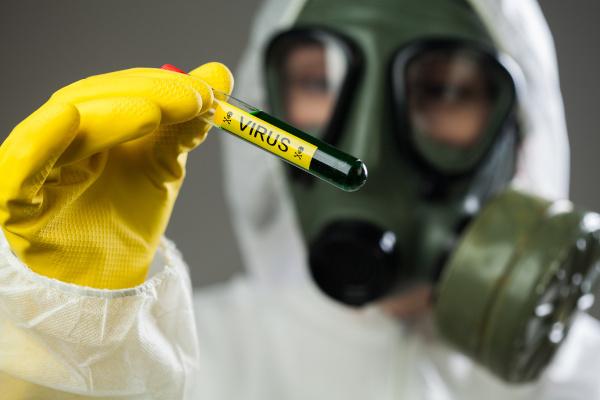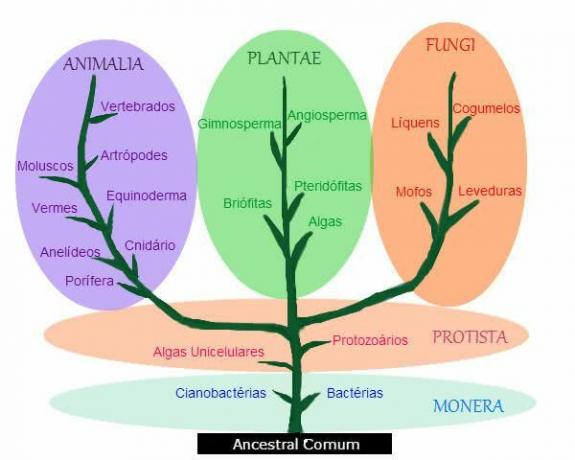biological weapons are weapons that transport organisms, such as virus and bacteria, capable of causing harm to the population, other animals and plants. The use of these weapons causes the spread of diseases that can put an entire population at risk and even trigger pandemics.
Since the beginning of human history, man has used micro-organisms as a way to defend himself and also to attack his enemies. As the study of microbiology and genetic engineering advances, these weapons have become increasingly effective and dangerous.
Read more: Great Epidemics of History
What are biological weapons?
Biological weapons are weapons that carry pathogenic microorganisms capable of causing disease and death in humans, other animals and plants. In addition to causing illness and death, biological weapons are used for the purpose of cause fear in a population, spreading insecurity and panic, which can cause great harm to people who live in a certain area, negatively impacting even its economy.

Biological weapons are extremely dangerous, and although they do not destroy the physical structure of a region, as the goodatomic mbas, the diseases they release can lead to epidemics and even pandemics., reaching different geographic regions.
Furthermore, because they do not cause large explosions, such as missiles and bombs, biological weapons are a silent danger, as they are released into the environment without people noticing. This causes a large number of people to be infected even before the threat has been identified. So it's It is important that health systems are always prepared to deal with these situations., responding quickly to known disease outbreaks as well as new agents.
Do not stop now... There's more after the advertising ;)
Types of biological weapons
There are different types of biological weapons, which differ, for example, by the agent used in their manufacture. Some of the microorganisms already used in the manufacture of biological weapons are bacteria Yersinia pestis and Bacillus anthracis. Biological weapons also differ in the way they are used, that is, how the micro-organism will be spread. In the literature there are reports of simple weapons, such as contaminated stakes, even missiles capable of spreading a biological agent.
Read more: Biological Weapons in the Paraguay War
Agents used in the manufacture of biological weapons
Different agents can be used in the manufacture of biological weapons, such as bacteria, viruses and fungi. Theoretically any biological agent can be used as a biological weapon, however, these microorganisms must have a series of important characteristics, such as being able to withstand handling and storage, being capable of being produced in scale, and be able to spread in adverse conditions so that they can be used, for example, as weapons in wars.
Currently, the advances in genetic engineering pose a major threat when it comes to biological weapons, since it is possible, through these techniques, to modify microorganisms, making them more efficient in their capacity to cause diseases and more resistant to the action of drugs.
The US Centers for Disease Control and Prevention (CDC) classifies biological agents into three categories: Category A, Category B, and Category C.
THE Category A is composed of high-priority agents, which include organisms that pose a great risk to national security due to the fact that they are easily disseminated or are transmitted from one person to another, have high mortality rates, cause panic and social disruption, and require special action for health preparedness. public. This category includes the causative agents ofsmallpox, tularemia, plague, botulismo and anthrax, for example.

At Category B are the second priority agents, which stand out for being moderately easy to spread, having rates moderate morbidity and low mortality rates, and require improved diagnostic and surveillance capacity. epidemiological. In this group, are included organisms causing typhus fever, viral encephalitis, brucellosisand that threaten the security of the Water, like the Vibrio cholerae, causative agent of cholera.
Finally, in the Category C, are emerging pathogens that could be projected for mass spread in the future due to the ease of being obtained and disseminated and the potential they have for high rates of mortality and morbidity, which would have a great impact on the health. In this case, causative agents of emerging infectious diseases are included, such as the Nipah virus and hantavirus.
Read more: Black Death Pandemic in the 14th Century
Biological Weapons Used in History
The use of biological weapons is not new in human history, this practice being observed since the THEseniority. Neanderthal man, for example, contaminated his arrows with the use of animal feces. The Romans, in turn, contaminated their enemies' wells by throwing animal carcasses into them. These weapons, however, were quite simple, with few infectious agents selected and the form of application not always effective.
The development of biological weapons gained momentum with advances in microbiology studies. With greater understanding of pathogenic microorganisms, it became possible to create elaborate weapons with a high capacity to infect large numbers of people.
During the First World War, the Germans developed several biological weapons, however, their impact is unknown. At Second World War, the production of biological weapons was also observed. As far as is known, only the Japanese, during the occupation of China, used biological weapons on a large scale. At the time, Japanese troops released plague-contaminated fleas (Yersinia pestis) in the region of China occupied by the Japanese Empire.
the old Soviet Union had an industrial complex, created in 1973, dedicated to the manufacture of biological weapons, which continued to manufacture these weapons even with the Convention for the Prohibition of Bacteriological Weapons (Biological) and Toxins and their Destruction (CPAB), established in 1972.
This manufacturing continuity was observed due to an anthrax epidemic in the Russian city of Sverdlovsk in 1979, which culminated in several deaths of people and other animals. It is believed that these spores were accidentally released into the environment during the transfer of Bacillus anthracis into containers.
A well-known case of the use of biological weapons occurred in 2001, when Terrorists have spread anthrax spores through the US postal system. This incident resulted in the death of five people.
By Vanessa Sardinha dos Santos
Biology teacher



